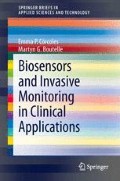Abstract
With the advance in nanotechnology and the use of materials such as silicon and CNT with excellent mechanical, optical and electrochemical properties, the factor that prevents the widespread use of implantable devices for clinical monitoring is their low reliability.
Access this chapter
Tax calculation will be finalised at checkout
Purchases are for personal use only
References
Arosio D, Ricci F, Marchetti L, Gualdani R, Albertazzi L, Beltram F (2010) Simultaneous intracellular chloride and pH measurements using a GFP-based sensor. Nat Methods 7:516–518
Byrne R, Benito-Lopez F, Diamond D (2010) Materials science and the sensor revolution. Mater Today 13:16–23
Daniel KD, Kim GY, Vassiliou CC, Galindo M, Guimaraes AR, Weissleder R, Charest A, Langer R, Cima MJ (2009) Implantable diagnostic device for cancer monitoring. Biosens Bioelectron 24:3252–3257
de la Rica R, Aili D, Stevens MM (2012) Enzyme-responsive nanoparticles for drug release and diagnostics. Adv Drug Deliv Rev 64:967–978
Gultepe E, Nagesha D, Sridhar S, Amiji M (2010) Nanoporous inorganic membranes or coatings for sustained drug delivery in implantable devices. Adv Drug Deliv Rev 62:305–315
Hovorka R (2011) Closed-loop insulin delivery: from bench to clinical practice. Nat Rev Endocrinol 7:385
Kaputa D, Price D, Enderle JD (2010) A portable, inexpensive, wireless vital signs monitoring system. Biomed Instrum Technol 44:350–353
Labroo P, Cui Y (2013) Flexible graphene bio-nanosensor for lactate. Biosens Bioelectron 41:852–856
Lee H, Sun E, Ham D, Weissleder R (2008) Chip-NMR biosensor for detection and molecular analysis of cells. Nat Med 14:869–874
Macvittie K, Halamek J, Halamkova L, Southcott M, Jemison WD, Lobel R, Katz E (2013) From “cyborg” lobsters to a pacemaker powered by implantable biofuel cells. Energy Environ Sci 6:81–86
Malecha K, Pijanowska DG, Golonka LJ, Kurek P (2011) Low temperature co-fired ceramic (LTCC)-based biosensor for continuous glucose monitoring. Sens Actuators B Chem 155:923–929
McLamore ES, Mohanty S, Shi J, Claussen J, Jedlicka SS, Rickus JL, Porterfield DM (2010) A self-referencing glutamate biosensor for measuring real time neuronal glutamate flux. J Neurosci Methods 189:14–22
Plaxco KW, Soh HT (2011) Switch-based biosensors: a new approach towards real-time, in vivo molecular detection. Trends Biotechnol 29:1–5
Pumera M (2011) Graphene in biosensing. Mater Today 14:308–315
Ramanavicius A, Kausaite A, Ramanaviciene A (2008) Enzymatic biofuel cell based on anode and cathode powered by ethanol. Biosens Bioelectron 24:761–766
Rogers M, Leong C, Niu X, de Mello A, Parker KH, Boutelle MG (2011) Optimisation of a microfluidic analysis chamber for the placement of microelectrodes. Phys Chem Chem Phys 13:5298–5303
Shi J, McLamore ES, Marshall Porterfield D (2013) Nanomaterial based self-referencing micro-biosensors for cell and tissue physiology research. Biosens Bioelectron 40:127–134
Vlandas A, Kurkina T, Ahmad A, Kern K, Balasubramanian K (2010) Enzyme-free sugar sensing in microfluidic channels with an affinity-based single-wall carbon nanotube sensor. Anal Chem 82:6090–6097
Yin R, Han J, Zhang J, Nie J (2010) Glucose-responsive composite microparticles based on chitosan, concanavalin A and dextran for insulin delivery. Colloids Surf B 76:483–488
Author information
Authors and Affiliations
Corresponding author
Rights and permissions
Copyright information
© 2013 The Author(s)
About this chapter
Cite this chapter
Córcoles, E.P., Boutelle, M.G. (2013). Conclusion and Future Trends. In: Biosensors and Invasive Monitoring in Clinical Applications. SpringerBriefs in Applied Sciences and Technology. Springer, Heidelberg. https://doi.org/10.1007/978-3-319-00360-3_11
Download citation
DOI: https://doi.org/10.1007/978-3-319-00360-3_11
Published:
Publisher Name: Springer, Heidelberg
Print ISBN: 978-3-319-00359-7
Online ISBN: 978-3-319-00360-3
eBook Packages: EngineeringEngineering (R0)

